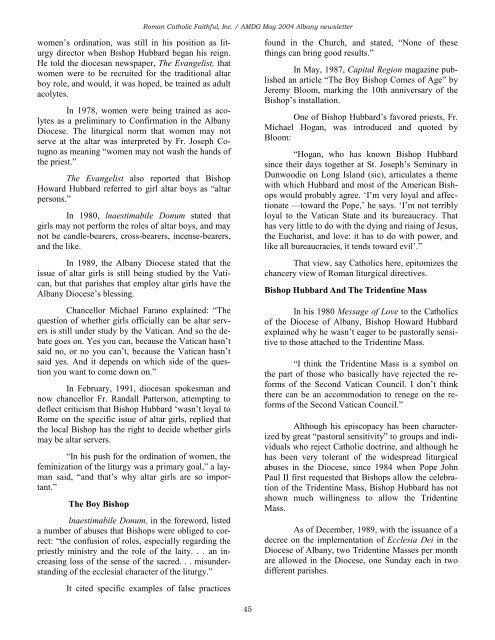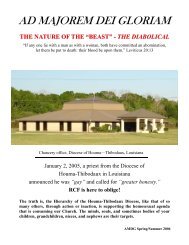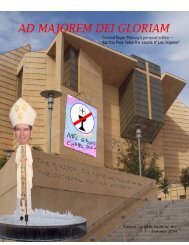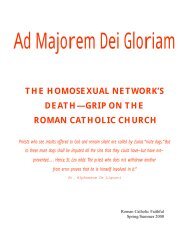<strong>Roman</strong> <strong>Catholic</strong> <strong>Faithful</strong>, Inc. / AMDG May 2004 <strong>Albany</strong> newsletterrecipe utilized left many believ<strong>in</strong>g that it was the“unofficial” reply of the Diocese, and that the breadused was justified by the fact that a Canadian liturgicalbullet<strong>in</strong> and a group at Notre Dame Universityapproved of altar breads made with that recipe.Mrs. Clough, however, is concerned withwhat she describes as the propaganda battle wagedaga<strong>in</strong>st the teach<strong>in</strong>g of the <strong>Catholic</strong> Church on thenature of the Mass and the sacraments conducted bythe Diocese.“Updat<strong>in</strong>g Courses”Two <strong>in</strong>cidents illustrate her concern. Whenone of her daughters was scheduled to receive herFirst Communion, she was advised that her daughterwould make her First Confession sometime afterward.She objected to her pastor, who told her thatif she wanted her daughter to make her First Confession,she would first have to prepare her herself.Pregnant with her n<strong>in</strong>th child, and exhaustedwith pneumonia at the time, Mrs. Clough (whose husbandis not <strong>Catholic</strong>) prepared her daughter. Twoweeks before the First Communion Mass, Mrs.Clough called her pastor to ask him if her daughter,Karen, could have her First Confession scheduled. Anun who answered the phone said that the priest wastoo busy, and to call back a week later.Aga<strong>in</strong>, Mrs. Clough called, and the priest,aga<strong>in</strong>, was too busy. Two days before the First Communion,Mrs. Clough called aga<strong>in</strong>, and was told thepriest didn’t have time.“So, my daughter couldn’t make her FirstConfession, first,” she said.Dur<strong>in</strong>g the time a child prepares for FirstCommunion, the child’s parents are required by theDiocese to enroll <strong>in</strong> “updat<strong>in</strong>g” courses.Mrs. Clough remembers, “I was <strong>in</strong> a class andthe teacher was say<strong>in</strong>g that theologians now believethat the first Mass wasn’t celebrated until the secondcentury.“I raised my hand and said, ‘I thought theFirst Mass was at the Last Supper,’ and the teachersaid, ‘That is a matter theologians are debat<strong>in</strong>g’.”A Polka MassTwo months after the Sacred Congregationfor the Sacraments and Div<strong>in</strong>e Worship publishedlnaestimabile Donum (April, 1980), which describedunnecessary outdoor celebrations of the Eucharist as aserious abuse, Bishop Howard Hubbard celebrated aPolka Mass on the Fonda Fair Grounds for Amsterdam’sannual Polka Fest ‘80.<strong>The</strong> noon Mass at the fairgrounds was celebratedbarely 500 feet from St. Cecilia’s Church, <strong>in</strong>the open-sided shed of a picnic grove, with the congregationsitt<strong>in</strong>g at picnic tables.This abuse is just one of many, say <strong>Albany</strong><strong>Catholic</strong>s, that happen with regularity.<strong>The</strong>re are ecumenical services where Protestantsand <strong>Catholic</strong>s receive Communion, serviceswhich are advertised as “a valid mass (sic) for <strong>Catholic</strong>swhile reta<strong>in</strong><strong>in</strong>g the mean<strong>in</strong>g of Holy Communionfor participat<strong>in</strong>g Protestants.” <strong>The</strong>re have beenMasses concelebrated with Protestant m<strong>in</strong>isters whoreceive Communion with the priest. <strong>The</strong>re cont<strong>in</strong>ue tobe Masses celebrated <strong>in</strong> the Diocese “where womendo all the work,” <strong>in</strong> the words of one <strong>Catholic</strong>. And as“earth worship” advances <strong>in</strong> <strong>Albany</strong>, there are moreand more “nature Masses” out <strong>in</strong> the woods, wherenatural elements are adored.“<strong>The</strong> radicals th<strong>in</strong>k they have a mandate to dowhatever they want,” said one priest, “and you can’ttell me this isn’t allowed to destroy the Church.”In his view, Bishop Hubbard’s support forwomen priests stems from a drive to humiliate hispriests.<strong>The</strong> priest told of “an event held <strong>in</strong> the cathedralwhere the Bishop was <strong>in</strong> the sanctuary, completelysurrounded by women who helped him‘concelebrate Mass,’ and then distributed Communion.Pack<strong>in</strong>g the first four pews were diocesan priests,reduced to spectators.”“Altar Persons”In 1976, the Diocese of <strong>Albany</strong> began an effortto br<strong>in</strong>g altar girls <strong>in</strong>to every parish.Fr. Richard Vosko, then director of the DiocesanLiturgy Center (and now a priest who operateshis own architectural firm, which specializes <strong>in</strong> renovat<strong>in</strong>gchurches throughout the United States), told<strong>The</strong> <strong>Albany</strong> Times Union that, while altar girls were aproblem <strong>in</strong> some areas of the United States, “it’s not areal issue with us” <strong>in</strong> the <strong>Albany</strong> Diocese. In 1976, healso said that the American Bishops had petitionedRome to allow them to use altar girls.In 1977, Fr. Vosko, a public advocate of44
<strong>Roman</strong> <strong>Catholic</strong> <strong>Faithful</strong>, Inc. / AMDG May 2004 <strong>Albany</strong> newsletterwomen’s ord<strong>in</strong>ation, was still <strong>in</strong> his position as liturgydirector when Bishop Hubbard began his reign.He told the diocesan newspaper, <strong>The</strong> Evangelist, thatwomen were to be recruited for the traditional altarboy role, and would, it was hoped, be tra<strong>in</strong>ed as adultacolytes.In 1978, women were be<strong>in</strong>g tra<strong>in</strong>ed as acolytesas a prelim<strong>in</strong>ary to Confirmation <strong>in</strong> the <strong>Albany</strong>Diocese. <strong>The</strong> liturgical norm that women may notserve at the altar was <strong>in</strong>terpreted by Fr. Joseph Cotugnoas mean<strong>in</strong>g “women may not wash the hands ofthe priest.”<strong>The</strong> Evangelist also reported that BishopHoward Hubbard referred to girl altar boys as “altarpersons.”In 1980, lnaestimabile Donum stated thatgirls may not perform the roles of altar boys, and maynot be candle-bearers, cross-bearers, <strong>in</strong>cense-bearers,and the like.In 1989, the <strong>Albany</strong> Diocese stated that theissue of altar girls is still be<strong>in</strong>g studied by the Vatican,but that parishes that employ altar girls have the<strong>Albany</strong> Diocese’s bless<strong>in</strong>g.Chancellor Michael Farano expla<strong>in</strong>ed: “<strong>The</strong>question of whether girls officially can be altar serversis still under study by the Vatican. And so the debategoes on. Yes you can, because the Vatican hasn’tsaid no, or no you can’t, because the Vatican hasn’tsaid yes. And it depends on which side of the questionyou want to come down on.”In February, 1991, diocesan spokesman andnow chancellor Fr. Randall Patterson, attempt<strong>in</strong>g todeflect criticism that Bishop Hubbard ‘wasn’t loyal toRome on the specific issue of altar girls, replied thatthe local Bishop has the right to decide whether girlsmay be altar servers.“In his push for the ord<strong>in</strong>ation of women, thefem<strong>in</strong>ization of the liturgy was a primary goal,” a laymansaid, “and that’s why altar girls are so important.”<strong>The</strong> Boy Bishoplnaestimabile Donum, <strong>in</strong> the foreword, listeda number of abuses that Bishops were obliged to correct:“the confusion of roles, especially regard<strong>in</strong>g thepriestly m<strong>in</strong>istry and the role of the laity. . . an <strong>in</strong>creas<strong>in</strong>gloss of the sense of the sacred. . . misunderstand<strong>in</strong>gof the ecclesial character of the liturgy.”It cited specific examples of false practicesfound <strong>in</strong> the Church, and stated, “None of theseth<strong>in</strong>gs can br<strong>in</strong>g good results.”In May, 1987, Capital Region magaz<strong>in</strong>e publishedan article “<strong>The</strong> Boy Bishop Comes of Age” byJeremy Bloom, mark<strong>in</strong>g the 10th anniversary of theBishop’s <strong>in</strong>stallation.One of Bishop Hubbard’s favored priests, Fr.Michael Hogan, was <strong>in</strong>troduced and quoted byBloom:“Hogan, who has known Bishop Hubbards<strong>in</strong>ce their days together at St. Joseph’s Sem<strong>in</strong>ary <strong>in</strong>Dunwoodie on Long Island (sic), articulates a themewith which Hubbard and most of the American Bishopswould probably agree. ‘I’m very loyal and affectionate—toward the Pope,’ he says. ‘I’m not terriblyloyal to the Vatican State and its bureaucracy. Thathas very little to do with the dy<strong>in</strong>g and ris<strong>in</strong>g of Jesus,the Eucharist, and love: it has to do with power, andlike all bureaucracies, it tends toward evil’.”That view, say <strong>Catholic</strong>s here, epitomizes thechancery view of <strong>Roman</strong> liturgical directives.Bishop Hubbard And <strong>The</strong> Trident<strong>in</strong>e MassIn his 1980 Message of Love to the <strong>Catholic</strong>sof the Diocese of <strong>Albany</strong>, Bishop Howard Hubbardexpla<strong>in</strong>ed why he wasn’t eager to be pastorally sensitiveto those attached to the Trident<strong>in</strong>e Mass.“I th<strong>in</strong>k the Trident<strong>in</strong>e Mass is a symbol onthe part of those who basically have rejected the reformsof the Second Vatican Council. I don’t th<strong>in</strong>kthere can be an accommodation to renege on the reformsof the Second Vatican Council.”Although his episcopacy has been characterizedby great “pastoral sensitivity” to groups and <strong>in</strong>dividualswho reject <strong>Catholic</strong> doctr<strong>in</strong>e, and although hehas been very tolerant of the widespread liturgicalabuses <strong>in</strong> the Diocese, s<strong>in</strong>ce 1984 when Pope JohnPaul II first requested that Bishops allow the celebrationof the Trident<strong>in</strong>e Mass, Bishop Hubbard has notshown much will<strong>in</strong>gness to allow the Trident<strong>in</strong>eMass.As of December, 1989, with the issuance of adecree on the implementation of Ecclesia Dei <strong>in</strong> theDiocese of <strong>Albany</strong>, two Trident<strong>in</strong>e Masses per monthare allowed <strong>in</strong> the Diocese, one Sunday each <strong>in</strong> twodifferent parishes.45
- Page 1 and 2: Roman Catholic Faithful, Inc. / AMD
- Page 3 and 4: Roman Catholic Faithful, Inc. / AMD
- Page 5 and 6: Roman Catholic Faithful, Inc. / AMD
- Page 7 and 8: Roman Catholic Faithful, Inc. / AMD
- Page 9 and 10: Roman Catholic Faithful, Inc. / AMD
- Page 11 and 12: Roman Catholic Faithful, Inc. / AMD
- Page 13 and 14: Roman Catholic Faithful, Inc. / AMD
- Page 15 and 16: Roman Catholic Faithful, Inc. / AMD
- Page 17 and 18: Roman Catholic Faithful, Inc. / AMD
- Page 19 and 20: Roman Catholic Faithful, Inc. / AMD
- Page 21 and 22: Roman Catholic Faithful, Inc. / AMD
- Page 23 and 24: Roman Catholic Faithful, Inc. / AMD
- Page 25 and 26: Roman Catholic Faithful, Inc. / AMD
- Page 27 and 28: Roman Catholic Faithful, Inc. / AMD
- Page 29 and 30: Roman Catholic Faithful, Inc. / AMD
- Page 31 and 32: Roman Catholic Faithful, Inc. / AMD
- Page 33 and 34: Roman Catholic Faithful, Inc. / AMD
- Page 35 and 36: Roman Catholic Faithful, Inc. / AMD
- Page 37 and 38: Roman Catholic Faithful, Inc. / AMD
- Page 39 and 40: Roman Catholic Faithful, Inc. / AMD
- Page 41 and 42: Roman Catholic Faithful, Inc. / AMD
- Page 43: Roman Catholic Faithful, Inc. / AMD
- Page 47 and 48: Roman Catholic Faithful, Inc. / AMD
- Page 49 and 50: Roman Catholic Faithful, Inc. / AMD
- Page 51 and 52: Roman Catholic Faithful, Inc. / AMD
- Page 53 and 54: Roman Catholic Faithful, Inc. / AMD
- Page 55 and 56: Roman Catholic Faithful, Inc. / AMD
- Page 57 and 58: Roman Catholic Faithful, Inc. / AMD
- Page 59 and 60: Roman Catholic Faithful, Inc. / AMD
- Page 61 and 62: Roman Catholic Faithful, Inc. / AMD
- Page 63 and 64: Roman Catholic Faithful, Inc. / AMD
- Page 65 and 66: Roman Catholic Faithful, Inc. / AMD
- Page 67 and 68: Roman Catholic Faithful, Inc. / AMD
- Page 69 and 70: Roman Catholic Faithful, Inc. / AMD
- Page 71 and 72: Roman Catholic Faithful, Inc. / AMD





